
Learn about aircraft carrier aviation with the US Navy.
- Subject:
- Applied Science
- Engineering
- History
- Material Type:
- Activity/Lab
- Author:
- National Air and Space Museum
- Date Added:
- 12/03/2021

Learn about aircraft carrier aviation with the US Navy.
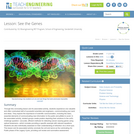
Through this concluding lesson and its associated activity, students experience one valuable and often overlooked skill of successful scientists and engineers communicating your work and ideas. They explore the importance of scientific communication, including the basic, essential elements of communicating new information to the public and pitfalls to avoid. In the associated activity, student groups create posters depicting their solutions to the unit's challenge question accurate, efficient methods for detecting cancer-causing genes using optical biosensors which includes providing a specific example with relevant equations. Students are also individually assessed on their understanding of refraction via a short quiz. This lesson and its associated activity conclude the unit and serve as the culminating Go Public phase of the Legacy Cycle, providing unit review and summative assessment.
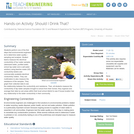
Students perform one of the first steps that environmental engineers do to determine water quality sampling and analysis. Student teams measure the electrical conductivity of four water samples (deionized water, purified water, school tap water and a salt-water solution) using teacher-made LED-conductivity testers and commercially available electrical conductivity meters. They use multimeters to also measure the resistance of the samples. They graph their collected data to see the relationship between the conductivity and resistance. Then, all students measure the conductivity of tap water samples brought to school from their homes; they organize and average their data by sub areas within their local school district to see if house location has any relationship to the water conductivity in their community.
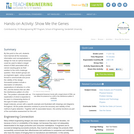
By this point in the unit, students have learned all the necessary information and conceptualized a design for how an optical biosensor could be used to detect a target strand of DNA associated with a cancer-causing gene as their solution to the unit's challenge question. Now student groups act as engineers again, using a poster format to communicate and prove the validity of the design. Successful posters include a description of refraction, explanations of refraction in a thin film, and the factors that can alter the interference pattern of a thin film. The posters culminate with an explanation of what is expected to be seen in a biosensing device of this type if it were coupled to a target molecule, proven with a specific example and illustrated with drawings and diagrams throughout. All the poster elements combine to prove the accuracy and viability of this method of gene detection. Together with its associated lesson, this activity functions as part of the summative assessment for this unit.
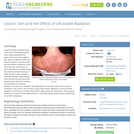
Towards finding a solution to the unit's Grand Challenge Question about using nanoparticles to detect, treat and protect against skin cancer, students continue the research phase in order to answer the next research questions: What is the structure and function of skin? How does UV radiation affect the chemical reactions that go on within the skin? After seeing an ultraviolet-sensitive bead change color and learning how they work, students learn about skin anatomy and the effects of ultraviolet radiation on human skin, pollution's damaging effect on the ozone layer that can lead to increases in skin cancer, the UV index, types of skin cancer, ABCDEs of mole and lesion evaluation, and the sun protection factor (SPF) rating system for sunscreens. This prepares students to conduct the associated activity, in which they design quality-control experiments to test SPF substances.
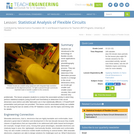
Students are introduced to the technology of flexible circuits, some applications and the photolithography fabrication process. They are challenged to determine if the fabrication process results in a change in the circuit dimensions since, as circuits get smaller and smaller (nano-circuits), this could become very problematic. The lesson prepares students to conduct the associated activity in which they perform statistical analysis (using Excel® and GeoGebra) to determine if the circuit dimension sizes before and after fabrication are in fact statistically different. A PowerPoint® presentation and post-quiz are provided. This lesson and its associated activity are suitable for use during the last six weeks of the AP Statistics course; see the topics and timing note for details.
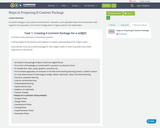
E-Content Package is very useful to all the learners. Herewith, I have uploaded Power Point Presentation with regard to the preparation of E-Content Package which is highly useful for the stakeholders.

The sustainability learning suites is a set of learning objects created for people with a post-secondary science background, organized in six themes: Systems thinking; Sustainable development; Population; Energy; Water and Materials. The materials are designed on Fink's Taxonomy of Significant Learning and include: learning objectives, editable slides with notes and embedded classroom activities, activities of 1-3 hours, assessments, and a set of 24 videos.
The “Systems Are Everywhere” module was originally written for high school science teachers or counselors to use in any setting (in class or in extracurricular programs). However, during field-testing, we found that many elementary and middle school teachers were able to use these lessons successfully with their students. The module is made up of three lessons that serve to foster students’ understanding of systems, systems models, and systems thinking at every level of learning and across many content areas. Blended throughout the lessons are career connections that will introduce students to diverse systems thinkers in STEM, and provide context for how systems approaches are used in real life to address complex problems. The lessons and module can be used as a stand-alone set of activities or can be integrated into any course as an extension or enrichment.
The module begins with students modeling a complex system. Students will brainstorm and sketch the parts and connections of the system, then use an online tool (Loopy) to model the interactions of those parts and connections. Next, students will develop their understanding of systems thinking skills and their application for addressing problems and solutions. Then, students will apply their knowledge and skills to model a system of their choosing. Lastly, they will showcase their skills by creating a student profile and integrating their systems thinking skills into a resume.
Target Audience
This is our introductory module that we recommend teaching before each of our other modules to give students a background in systems and to help them understand the many careers available in STEM. This module can be applied easily to any content area and works best as written for students between 6th and 12th grades but can be adapted for other ages. It works very well when teaching virtually and in-person. If you are looking for an introduction to systems that can be delivered in-person with more kinesthetic activities, please see our Introduction to Systems module. The Intro to Systems module works best with 8-12 grade students, though can be used with some modifications for 6-7th graders. This Systems are Everywhere module can work well for elementary through secondary grades.
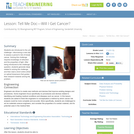
Students are introduced to the unit challenge discovering a new way to assess a person's risk of breast cancer. Solving this challenge requires knowledge of refraction and the properties of light. After being introduced to the challenge question, students generate ideas related to solving the challenge, and then read a short online article on optical biosensors that guides their research towards solving the problem.
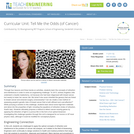
Through four lessons and three hands-on activities, students learn the concepts of refraction and interference in order to solve an engineering challenge: "In 2013, actress Angelina Jolie underwent a double mastectomy, not because she had been diagnosed with breast cancer, but merely to lower her cancer risk. But what if she never inherited the gene(s) that are linked to breast cancer and endured surgery unnecessarily? Can we create a new method of assessing people's genetic risks of breast cancer that is both efficient and cost-effective?" While pursuing a solution to this challenge, students learn about some high-tech materials and delve into the properties of light, including the equations of refraction (index of refraction, Snell's law). Students ultimately propose a method to detect cancer-causing genes by applying the refraction of light in a porous film in the form of an optical biosensor. Investigating this challenge question through this unit is designed for an honors or AP level physics class, although it could be modified for conceptual physics.
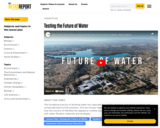
The increasing scarcity of drinking water has captured the world’s attention and driven scientists and conservationists to find solutions. This ten-minute video and accompanying lesson has students examine how the country of Namibia has tapped an unlikely source of water to combat shortages and experiment with water filtration materials and strategies.
This lesson is not under an open license; however it is provided free for educational services.
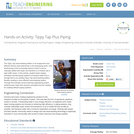
The Tippy Tap hand-washing station is an inexpensive and effective device used extensively in the developing world. One shortcoming of the homemade device is that it must be manually refilled with water and therefore is of limited use in high-traffic areas. In this activity, student teams design, prototype and test piping systems to transport water from a storage tank to an existing Tippy Tap hand-washing station, thereby creating a more efficient hand-washing station. Through this example service-learning engineering project, students learn basic fluid dynamic principles that are needed for creating efficient piping systems.
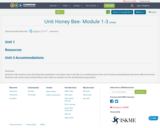
Students will examine ways declining bee population can impact day to day life, by considering how the cost of honey and pollination has been affected society Students will create real-world problems that relate to statistics on the declining bee population.
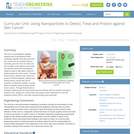
This unit on nanoparticles engages students with a hypothetical Grand Challenge Question that asks about the skin cancer risk for someone living in Australia, given the local UV index and the condition of the region's ozone layer. The question asks how nanoparticles might be used to help detect, treat and protect people from skin cancer. Through three lessons, students learn about the science of electromagnetic radiation and energy waves, human skin and its response to ultraviolet radiation, and the state of medical nanotechnology related to skin cancer. Through three hands-on activities, students perform flame tests to become familiar with the transfer of energy in quantum form, design and conduct their own quality-control experiments to test sun protection factors (SPFs), and write nanotechnology grant proposals.

Students are presented with a biomedical engineering challenge: Breast cancer is the second-leading cause of cancer-related death among women and the American Cancer Society says mammography is the best early-detection tool available. Despite this, many women choose not to have them; of all American women at or over age 40, only 54.9% have had a mammogram within the past year. One reason women skip annual mammograms is pain, with 90% reporting discomfort. Is there a way to detect the presence of tumors that is not as painful as mammography but more reliable and quantifiable than breast self-exams or clinical breast exams? This three lesson/three activity unit is designed for first-year accelerated or AP physics classes. It provide hands-on activities to teach the concepts of stress, strain and Hooke's law, which students apply to solve the challenge problem.
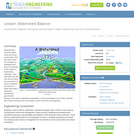
Students learn about the water cycle and its key components. First, they learn about the concept of a watershed and why it is important in the context of engineering hydrology. Then they learn how we can use the theory of conservation of mass to estimate the amount of water that enters a watershed (precipitation, groundwater flowing in) and exits a watershed (evaporation, runoff, groundwater out). Finally, students learn about runoff and how we visualize runoff in the form of hydrographs.

Students are presented with the unit's grand challenge problem: You are the lead engineer for a biomaterials company that has a cardiovascular systems client who wants you to develop a model that can be used to test the properties of heart valves without using real specimens. How might you go about accomplishing this task? What information do you need to create an accurate model? How could your materials be tested? Students brainstorm as a class, then learn some basic information relevant to the problem (by reading the transcript of an interview with a biomedical engineer), and then learn more specific information on how heart tissues work their structure and composition (lecture information presented by the teacher). This prepares them for the associated activity, during which students cement their understanding of the heart and its function by dissecting sheep hearts to explore heart anatomy.
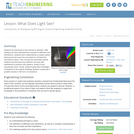
Students are introduced to the concept of refraction. After making sure they understand the concepts of diffraction and interference, students work collaboratively to explain optical phenomena that cannot be accounted for via these two mechanisms alone. Then, through the associated activity, students see first-hand how refraction can work with interference to produce color patterns, similar to how nanosensors work. Finally, students apply their knowledge of refraction to the original challenge question to generate a possible solution in the form of a biosensor.
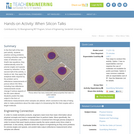
In the first half of this two-part activity, students practice solving problems involving refraction using the index of refraction and Snell's law equations; they mathematically solve for precise angles and speeds caused by refraction. In the second half of the activity, a hands-on lab, they apply the analytical skills required by the problem set to reflectance measurements of porous silicon thin films, including how reflectance measurements would change if various aspects of the film were altered. Students predict the data output in the form of reflectance measurements when samples are altered, which connects to the idea of being able to make predictions about the data output of a biosensing thin film that couples with a target molecule.